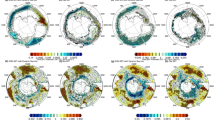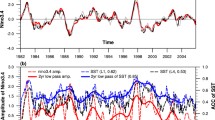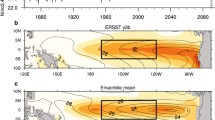Abstract
A coupled earth system model (ESM) has been developed at the Nanjing University of Information Science and Technology (NUIST) by using version 5.3 of the European Centre Hamburg Model (ECHAM), version 3.4 of the Nucleus for European Modelling of the Ocean (NEMO), and version 4.1 of the Los Alamos sea ice model (CICE). The model is referred to as NUIST ESM1 (NESM1). Comprehensive and quantitative metrics are used to assess the model’s major modes of climate variability most relevant to subseasonal-to-interannual climate prediction. The model’s assessment is placed in a multi-model framework. The model yields a realistic annual mean and annual cycle of equatorial SST, and a reasonably realistic precipitation climatology, but has difficulty in capturing the spring-fall asymmetry and monsoon precipitation domains. The ENSO mode is reproduced well with respect to its spatial structure, power spectrum, phase locking to the annual cycle, and spatial structures of the central Pacific (CP)-ENSO and eastern Pacific (EP)-ENSO; however, the equatorial SST variability, biennial component of ENSO, and the amplitude of CP-ENSO are overestimated. The model captures realistic intraseasonal variability patterns, the vertical-zonal structures of the first two leading predictable modes of Madden-Julian Oscillation (MJO), and its eastward propagation; but the simulated MJO speed is significantly slower than observed. Compared with the T42 version, the high resolution version (T159) demonstrates improved simulation with respect to the climatology, interannual variance, monsoon-ENSO lead-lag correlation, spatial structures of the leading mode of the Asian-Australian monsoon rainfall variability, and the eastward propagation of the MJO.
Article PDF
Similar content being viewed by others
Avoid common mistakes on your manuscript.
References
Annamalai, H., K. Hamilton, and K. R. Sperber, 2007: The south Asian Summer Monsoon and its relationship with ENSO in the IPCC AR4 simulation. J. Climate, 20, 1071–1092.
An, S.-I., and B. Wang, 2001: Mechanisms of locking of the El Niño and La Nina mature phases to boreal winter. J. Climate, 14, 2164–2176.
Ashok, K., S. Behera, A. S. Rao, H. Y. Weng, and T. Yamagata, 2007: El Ninõ Modoki and its teleconnection. J. Geophys. Res., 112, C11007, doi: 10.1029/2006JC003798.
Barnier, B., and Coauthors, 2006: Impact of partial steps and momentum advection schemes in a global ocean circulation model at eddy-permitting resolution. Ocean Dyn., 56, 543–567.
Bengtsson, L., U. Schlese, E. Roeckner, M. Latif, T. P. Barnett, and N. E. Graham, 1993: A Two-tiered approach to Long-range climate forecasting. Science, 261, 1027–1029.
Cane, M., S. E. Zebiak, and S. C. Dolan, 1986: Experimental forecasts of El Ninõ. Nature, 321, 827–832.
Dai, Y. J., and Coauthors, 2003: The Common Land Model. Bull. Amer. Meteor. Soc., 84, 1013–1023.
Dai, Y. J., R. E. Dickinson, and Y.-P. Wang, 2004: A two-big-leaf model for canopy temperature, photosynthesis, and stomatal conductance. J. Climate, 17, 2281–2299.
Davey, M., and Coauthors, 2002: A study of coupled model climatology and variability in tropical ocean regions. Climate Dyn., 18, 403–420.
Ding, Q. H., E. J. Steig, D. S. Battisti, and M. Küttel, 2011: Winter warming inWest Antarctica caused by central tropical Pacific warming. Nature Geoscience, 4, 398–403.
Ding, Y., Y. Ni, X. Zhang, W. Li, M. Dong, Z.-C. Zhao, Z. Li, and W. Shen, 2000: Introduction to the Short-term Climate Prediction Model System. China Meteorological Press, Beijing, China, 500 pp. (in Chinese)
Fouquart, Y., and B. Bonnel, 1980: Computations of solar heating of the earth’s atmosphere: A new parameterization. Beiträge zur Atmosphärenphysik, 53, 35–62.
Gadgil, S., and S. Sajani, 1998: Monsoon precipitation in the AMIP runs. Climate Dyn., 14, 659–689.
Goswami, B. N., 1998: Interannual variations of Indian Summer Monsoon in a GCM: External conditions versus internal feedbacks. J. Climate, 11, 501–522.
Hazeleger, W., and Coauthors, 2010: EC-Earth: A seamless Earth-System prediction approach in action. Bull. Amer. Meteor. Soc., 91, 1357–1363.
Hewitt, H. T., D. Copsey, I. D. Culverwell, C. M. Harris, R. S. R. Hill, A. B. Keen, A. J. McLaren, and E. C. Hunke, 2011: Design and implementation of the infrastructure of HadGEM3: The next-generation Met Office climate modelling system. Geoscientific Model Development, 4, 223–253.
Huffman, G. J., R. F. Adler, D. T. Bolvin, and G. J. Gu, 2009: Improving the global precipitation record: GPCP Version 2.1. Geophys. Res. Lett., 36, L17808, doi: 10.1029/2009GL040000.
Hunke, E. C., and W. H. Lipscomb, 2010: CICE: The Los Alamos Sea Ice Model Documentation and Software User’s Manual Version 4.1. LA-CC-06-012, T-3 Fluid Dynamics Group, Los Alamos National Laboratory, Los Alamos N.M.
Ji, D., and Coauthors, 2014: Description and basic evaluation of BNU-ESM version 1. Geoscientific Model Development Discussions, 7, 1601–1647.
Kanamitsu, M., W. Ebisuzaki, J. Woollen, S.-K. Yang, J. J. Hnilo, M. Fiorino, and G. L. Potter, 2002: NCEP-DOE AMIP-II Reanalysis (R-2). Bull. Amer. Meteor. Soc., 83, 1631–1643.
Kao, H.-Y., and J.-Y. Yu, 2009: Contrasting Eastern-Pacific and Central-Pacific types of ENSO. J. Climate, 22, 615–632.
Kim, H.-M., P. J. Webster, and J. A. Curry, 2009: Impact of shifting patterns of Pacific Ocean warming on north Atlantic tropical cyclones. Science, 325, 77–80.
Larson, J., R. Jacob, and E. Ong, 2005: The model coupling toolkit: A new Fortran 90 toolkit for building multiphysics parallel coupled models. International Journal of High Performance Computing Applications, 19(3), 277–292.
Latif, M., and Coauthors, 2001: ENSIP: The El-Niño simulation intercomparison project. Climate Dyn., 18, 255–276.
Lau, N.-C., and M. J. Nath, 2000: Impact of ENSO on the variability of the Asian-Australian monsoons as simulated in GCM experiments. J. Climate, 13, 4287–4309.
Lee, J.-Y., and B. Wang, 2014: Future change of global monsoon in the CMIP5. Climate Dyn., 42, 101–119.
Lee, J.-Y., and Coauthors, 2010: How are seasonal prediction skills related to models’ performance on mean state and annual cycle? Climate Dyn., 35, 267–283.
Lengaigne, M., G. Madec, L. Bopp, C. Menkes, O. Aumont, and P. Cadule, 2009: Bio-physical feedbacks in the Arctic Ocean using an Earth system model. Geophys. Res. Lett., 36, L21602. doi: 10.1029/2009GL040145.
Le Sommer, J., T. Penduff, S. Theetten, G. Madec, and B. Barnier, 2009: How momentum advection schemes influence currenttopography interactions at eddy permitting resolution. Ocean Modelling, 29(1), 1–14.
Liebmann, B., and C. A. Smith, 1996: Description of a complete (interpolated) outgoing longwave radiation dataset. Bull. Amer. Meteor. Soc., 77, 1275–1277.
Liu, L., G. Yang, B. Wang, C. Zhang, R. Li, Z. Zhang, Y. Ji, and L. Wang, 2014: C-Coupler1: A Chinese community coupler for Earth system modelling. Geoscientific Model Development Discussions, 7, 3889–3936.
Lohmann, U., and E. Roeckner, 1996: Design and performance of a new cloud microphysics scheme developed for the ECHAM general circulation model. Climate Dyn., 12, 557–572.
Madec, G., and the NEMO team, 2012: NEMO ocean engine. Note du ple de modélisation, No 27, Institut Pierre-Simon Laplace (IPSL), France.
Madec, G., P. Delecluse, M. Imbard, and C. Levy, 1998: OPA 8.1 ocean general circulation model-reference manual. Tech. Rep., LODYC/IPSL Note 11, Institut Pierre-Simon Laplace (IPSL), France, 91 pp.
Manabe, S., and K. Bryan, 1969: Climate calculation with a combined ocean-atmosphere model. J. Atmos. Sci., 26, 786–789.
Mechoso, C. R., and Coauthors, 1995: The seasonal cycle over the Tropical Pacific in Coupled Ocean-Atmosphere General Circulation Models. Mon. Wea. Rev., 123, 2825–2838.
Mitchell, T. P., and J. M. Wallace, 1992: On the annual cycle in equatorial convection and sea surface temperature. J. Climate, 5, 1140–1156.
Mlawer, E. J., S. J. Taubman, P. D. Brown, M. J. Iacono, and S. A. Clough, 1997: Radiative transfer for inhomogeneous atmospheres: RRTM, a validated correlated-k model for the longwave. J. Geophys. Res., 102, 16663–16682.
Nigam, S., and Y. Chao, 1995: On the evolution of the tropical ocean-atmosphere annual-cycle. TOGA Notes, 18, Nova University Press, 12–16.
Qiao, F. L., Z. Y. Song, Y. Bao, Y. J. Song, Q. Shu, C. J. Huang, and W. Zhao, 2013: Development and evaluation of an Earth System Model with surface gravity waves. J. Geophys. Res.: Oceans, 118, 514–4524.
Roeckner, E., and Coauthors, 2003: The atmospheric general circulation model ECHAM5. Part I: Model description. Rep. No. 349, Max-Planck-Institut für Meteorologie, Hamburg, Germany, 127 pp.
Saji, N. H., and T. Yamagata, 2003: Possible impacts of Indian Ocean Dipole mode events on global climate. Climate Res., 25, 151–169.
Smith, T. M., and R. W. Reynolds, 2004: Improved extended reconstruction of SST (1854–1997). J. Climate, 17, 2466–2477.
Sperber, K. R., and T. N. Palmer, 1996: Interannual tropical rainfall variability in general circulation model simulations associated with the atmospheric model intercomparison project. J. Climate, 9, 2727–2750.
Tiedtke, M., 1989: A comprehensive mass ux scheme for cumulus parameterization in largescale models. Mon. Wea. Rev., 117, 1779–1800.
Turner, A. G., P. M. Inness, and J. M. Slingo, 2005: The role of the basic state in the ENSO-monsoon relationship and implications for predictability. Quart. J. Roy. Meteor. Soc., 131, 781–804.
Vitart, F., W. Robertson, and D. L. T. Anderson, 2012: Subseasonal to Seasonal Prediction Project: Bridging the gap between weather and climate. WMO Bulletin, 61(2), 23–28.
Waliser, D. E., 2011: Predictability and forecasting. Intraseasonal Variability in the Atmosphere-Ocean Climate System, 2nd ed., W. K. M. Lau and D. E. Waliser, Eds., Springer, 433–476.
Waliser, D., and Coauthors, 2009: MJO simulation diagnostics. J. Climate, 22, 3006–3030.
Wang, B., and S.-I. An, 2005: A method for detecting seasondependent modes of climate variability: S-EOF analysis. Geophys. Res. Lett., 32, L15710, doi: 10.1029/2005GL022709.
Wang, B., and Q. H. Ding, 2008: Global monsoon: Dominant mode of annual variation in the tropics. Dyn. Atmos. Oceans, 44, 165–183.
Wang, B., R. G. Wu, and X. H. Fu, 2000: Pacific-East Asia teleconnection: How does ENSO affect East Asian climate? J. Climate, 13, 1517–1536.
Wang, B., I.-S. Kang, and J.-Y. Lee, 2004: Ensemble simulations of Asian-Australian Monsoon variability by 11 AGCMs. J. Climate, 17, 803–818.
Wang, B., Q. H. Ding, X. H. Fu, I.-S. Kang, K. Jin, J. Shukla, and F. Doblas-Reyes, 2005: Fundamental challenge in simulation and prediction of summer monsoon rainfall. Geophys. Res. Lett., 32, L15711, doi: 10.1029/2005GL022734.
Wang, B., J. Yang, T. J. Zhou, and B. Wang, 2008a: Interdecadal changes in the major modes of Asian-Australian monsoon variability: Strengthening relationship with ENSO since the late 1970s. J. Climate, 21, 1771–1789, doi: 10.1175/2007JCLI1981.1.
Wang, B., and Coauthors, 2008b: How accurately do coupled climate models predict the leading modes of Asian-Australian monsoon interannual variability? Climate Dyn., 30, 605–619.
Wang, B., and Coauthors, 2009: Advance and prospect of seasonal prediction: Assessment of the APCC/CliPAS 14-model ensemble retroperspective seasonal prediction (1980–2004). Climate Dyn., 33, 90–117.
Wang, B., H. J. Kim, K. Kikuchi, and A. Kitoh, 2011: Diagnostic metrics for evaluation of annual and diurnal cycles. Climate Dyn., 37, 941–955.
Wang, B., J.-Y. Lee, and B. Xiang, 2014: Asian summer monsoon rainfall predictability: A predictable mode analysis. Climate Dyn., doi: 10.1007/s00382-014-2218-1.
Wheeler, M., and G. N. Kiladis, 1999: Convectively coupled equatorial waves: Analysis of clouds and temperature in the wavenumber-frequency domain. J. Atmos. Sci., 56, 374–399.
Wheeler, M. C., and H. H. Hendon, 2004: An All-season Realtime multivariate MJO index: Development of an index for monitoring and prediction. Mon. Wea. Rev., 132, 1917–1932.
Xiang, B. Q., B. Wang, Q. H. Ding, F.-F. Jin, X. H. Fu, and H.-J. Kim, 2012: Reduction of the thermocline feedback associated with mean SST bias in ENSO simulation. Climate Dyn., 39, 1413–1430.
Xiang, B. Q., B. Wang, and T. Li, 2013: A new paradigm for the predominance of standing Central Pacific Warming after the late 1990s. Climate Dyn., 41(2), 327–340.
Yeh, S.-W., J.-S. Kug, B. Dewitte, M.-H. Kwon, B. Kirtman, and F.-F. Jin, 2009: El Ninõ in a changing climate. Nature, 461, 511–514, doi: 10.1038/nature08316.
Yu, Y. Q., and Coauthors, 2008: Coupled model simulations of climate changes in the 20th century and beyond. Adv. Atmos. Sci., 25(4), 641–654, doi: 10.1007/s00376-008-0641-0.
Zalesak, S. T., 1979: Fully multidimensional flux corrected transport algorithms for fluids. J. Comput. Phys., 31, 335–362.
Zebiak, S. E., and M. A. Cane, 1987: A model El-Niño-Southern Oscillation. Mon. Wea. Rev., 115, 2262–2278.
Zhang, C. D., J. Gottschalck, E. D. Maloney, M. W. Moncrieff, F. Vitart, D. E. Waliser, B. Wang, and M. C. Wheeler, 2013: Cracking the MJO nut. Geophys. Res. Lett., 40, 1223–1230, doi: 10.1002/grl.50244.
Author information
Authors and Affiliations
Corresponding author
Rights and permissions
Open Access This article is licensed under a Creative Commons Attribution 4.0 International License, which permits use, sharing, adaptation, distribution and reproduction in any medium or format, as long as you give appropriate credit to the original author(s) and the source, provide a link to the Creative Commons licence, and indicate if changes were made.
The images or other third party material in this article are included in the article’s Creative Commons licence, unless indicated otherwise in a credit line to the material. If material is not included in the article’s Creative Commons licence and your intended use is not permitted by statutory regulation or exceeds the permitted use, you will need to obtain permission directly from the copyright holder.
To view a copy of this licence, visit https://creativecommons.org/licenses/by/4.0/.
About this article
Cite this article
Cao, J., Wang, B., Xiang, B. et al. Major modes of short-term climate variability in the newly developed NUIST Earth System Model (NESM). Adv. Atmos. Sci. 32, 585–600 (2015). https://doi.org/10.1007/s00376-014-4200-6
Received:
Revised:
Accepted:
Published:
Issue Date:
DOI: https://doi.org/10.1007/s00376-014-4200-6




